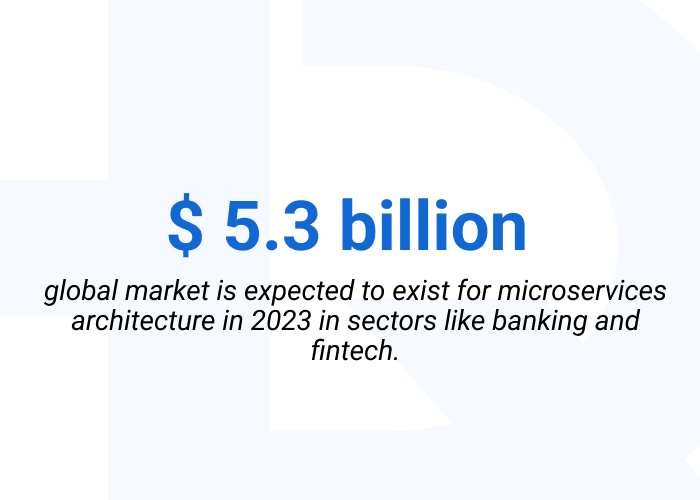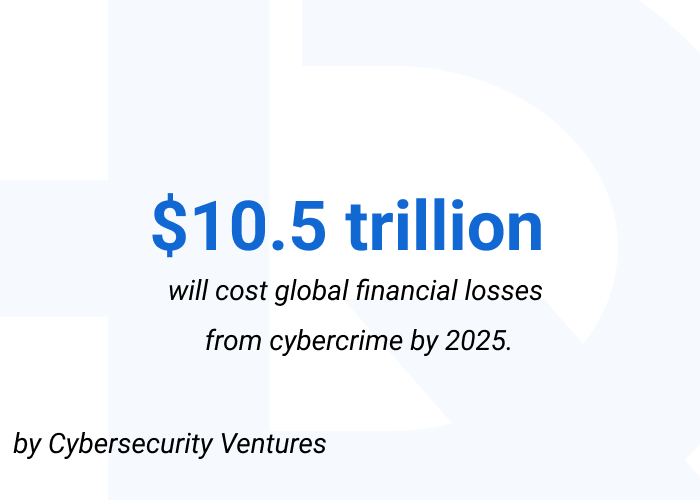What are Microservices in Banking and FinTech Development?
Benefits of Microservices Architecture for FinTech Development
Microservices architecture has grown in popularity in recent years, notably in industries such as banking and fintech, with an estimated global market size of $5.31 billion in 2023. By breaking down large systems into smaller, autonomous services, fintech microservices architecture provides a variety of benefits that can boost your business considerably.
These are not the only microservice architecture benefits. In this blog post, we will explore how microservices architecture in banking and fintech can improve data security, enhance scalability, and drive business growth. Whether you work in a financial institution or develop fintech solutions, we will provide valuable insights as to why microservices architecture is becoming the go-to choice for your company.
What are Microservices in Banking and FinTech Development?
Benefits of Microservices Architecture for FinTech Development
Microservices can be an excellent fit for banking and financial management software, thanks to their modular nature, scalability, and ability to align closely with specific financial operations, e.g. payments, transfers, loans, etc.
With the architecture of fintech microservices, huge, monolithic financial applications are broken down into smaller, independent modules. Each module is responsible for performing one specific task and communicates with other services over well-defined APIs. Since modules are isolated, errors in one module don’t impact the performance of others. Also, if one microservice has a surge in traffic, only that service needs to scale up, not the whole application.
Microservices improve agility as new features can be developed and deployed rapidly without affecting the whole system. You can create, test, and deploy each service independently.

Microservices architecture is well aligned with the needs of modern fintech applications that require rapid innovation, elastic scalability, high resilience, and regulatory compliance. The main microservices architecture benefits include:
Microservices can be created using various programming languages, development environments, and storage technologies. To meet the needs of a particular solution, you can use and combine multiple frameworks for distinct components. So, developers can choose the most appropriate technology for each particular functionality, which improves performance and shortens the development process.
Using microservices architecture for banking and fintech applications allows you to develop, update, and deploy individual services separately. Since each microservice is focused on carrying out a single process, it has separate data storage, business logic, and communication interfaces. So you can add new features without disrupting existing functionality. As a result, if the systems malfunction, it’s less likely to cause a broader system failure.
Microservices are particularly popular among banks. Typically, banks have complex and highly regulated systems that require significant customization and flexibility. The benefit of microservices architecture here is that banks can create a more agile and responsive technology infrastructure that adapts to changing business needs and market conditions. For example, you can create separate modules for account management, payment processing, fraud detection, and risk management.
As microservice architecture contains separate modules, it’s highly convenient for large development teams. Specialists can work on different modules concurrently, reducing dependencies and increasing productivity.
For example, as an outsourcing fintech provider, at HQSoftware, we can break down your fintech applications into smaller, more manageable services and work on different components independently. This results in shorter development cycles and enables teams to release updates and new features more frequently.
Want to incorporate microservices architecture into your fintech software? We’re ready to help!HQSoftware has a team of skilled professionals ready to tackle the project. Let’s talk!
Anna Halias
Business Development Manager
Cybersecurity Ventures predicts that global cybercrime financial losses will grow to $10.5 trillion by 2025. Microservices architecture can help you avoid sustaining one of these losses by improving the security of your financial solutions.
Microservices enable you to implement safety measures such as authentication and authorization at the individual service level, reducing the risk of data breaches and unauthorized access.
You can also incorporate encryption, which helps protect sensitive and financial data that is transmitted between microservices. Since modules are separated, all the data in one module stays safe in case of a collapse of the others. This improves the resilience of the fintech application, protecting huge amounts of sensitive data.

In addition, as each module is focused on a certain service, it’s much easier to ensure they comply with unique financial regulations around security, availability and transparency.
Traditionally, data management in fintech relied on centralized databases and monolithic architectures. Decentralized data management, however, has emerged as a more scalable and adaptable alternative with the quick development of banking microservices architecture.
Different services have different data storage requirements in terms of scale, performance, consistency, and redundancy, which enables autonomous information management and control. So, there is no need to scale a single large database for the whole system, as databases can be scaled independently based on the demands of each microservice.
As well, migration of a single service’s database has minimal impact on other services, since the data is isolated.
By splitting a large application into smaller, independent services, microservice architecture benefits in reducing development and maintenance costs as changes can be made to individual services or just components instead of the entire application.
By using this modular approach, you can discover performance bottlenecks, and quickly identify and fix problems. By reducing downtime and strengthening troubleshooting skills, this proactive strategy lowers operating costs.
Because microservices are designed to function independently, you can isolate and address possible issues easier and faster, protecting the whole system from failures. Resilience, on the other hand, focuses on the ability of a system to recover quickly after disruptions or system collapse.
By incorporating fault tolerance and resilience principles, microservice architectures can provide robustness, analyze system behavior, and identify areas of improvement.
As your financial software provider, we design microservices in a way that they can detect and isolate faults. We implement strategies such as circuit breakers and bulkheads to limit the impact of collapse on the overall system.
Microservice architecture maintains backward compatibility — coexistence of both the old and new versions of your application. Thus, you can minimize disruption for existing users when newer versions are released. This guarantees that existing functionality is maintained for users who have not yet upgraded their apps and allows them to upgrade systems without losing access to existing data or functionalities.
For example, service APIs can be versioned independently to avoid breaking changes as the system evolves.
In fintech, agile development enables you to rapidly develop, test, and deploy new microservices or update existing ones. Using an agile development cycle, you can respond quickly to changing business requirements or market conditions and provide faster time-to-market.
This approach promotes collaboration between development teams and business stakeholders, ensuring that the delivered microservices meet customer needs and align with business goals.
All of these practices facilitate frequent software releases and enhance the resilience and maintainability of microservices, enabling you to grow in the dynamic fintech landscape. By adopting them at HQSoftware, we are developing top-notch solutions that help you improve fault isolation, choose the most effective technologies for various features, and reduce time-to-market.
In light of the benefits of microservices for financial software development, our customers also choose microservice architecture for their banking and fintech solutions. Among them is Evolv — a leading company in providing audits for self-managed super funds in Australia.
They decided to enhance the performance of their existing software by switching from monolithic to microservice architecture. With microservices architecture, our client received the following improvements:
The expanded capabilities made our client an industry leader, enabling them to audit more than 20,000 pension funds throughout Australia. Furthermore, improved system performance allows the customer to sell this white-label solution to other companies, creating an additional revenue channel.
Overall, banking and fintech microservices architecture can help fintech companies create more responsive systems that adapt to changing market conditions and customer needs while improving:
Microservices architecture for banking and fintech applications enables you to innovate and experiment with new technologies and services more easily, without compromising the stability and reliability of existing systems.
At HQSoftware, we have deep experience in creating comprehensive financial software that will help boost your business. To provide you with top-tier solutions, we can advance your app with cutting-edge technologies such as Artificial Intelligence, Machine Learning, IoT, etc. Feel free to contact us to learn more about our financial software development services.

Lead Software Engineer
An experienced developer with a passion for IoT. Having participated in more than 20 Internet of Things projects, shares tips and tricks on connected software development.
We are open to seeing your business needs and determining the best solution. Complete this form, and receive a free personalized proposal from your dedicated manager.

Sergei Vardomatski
Founder